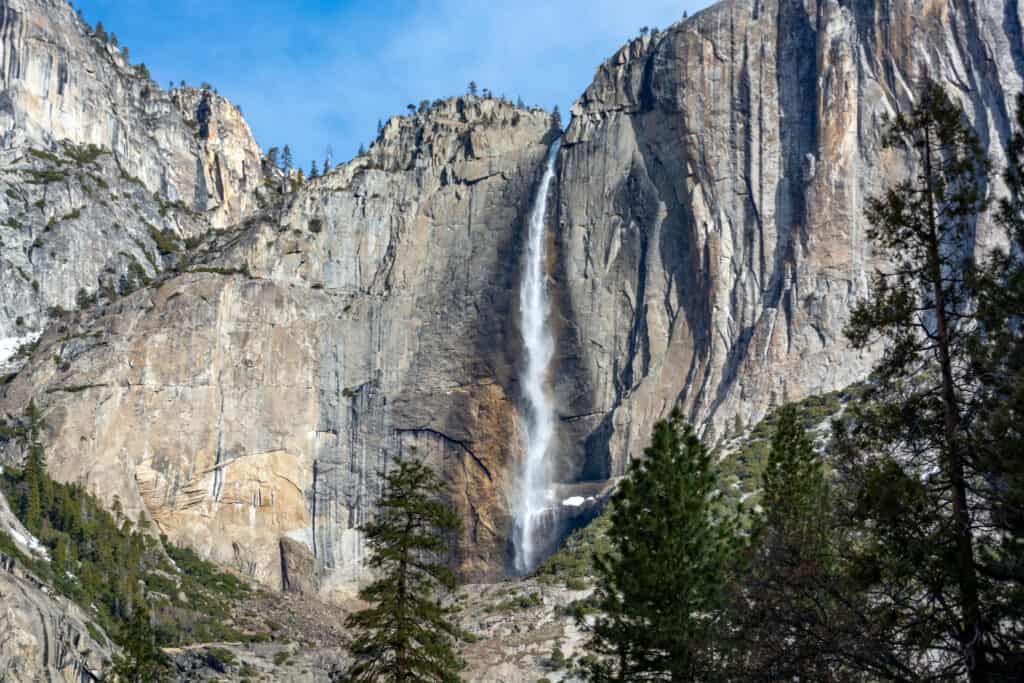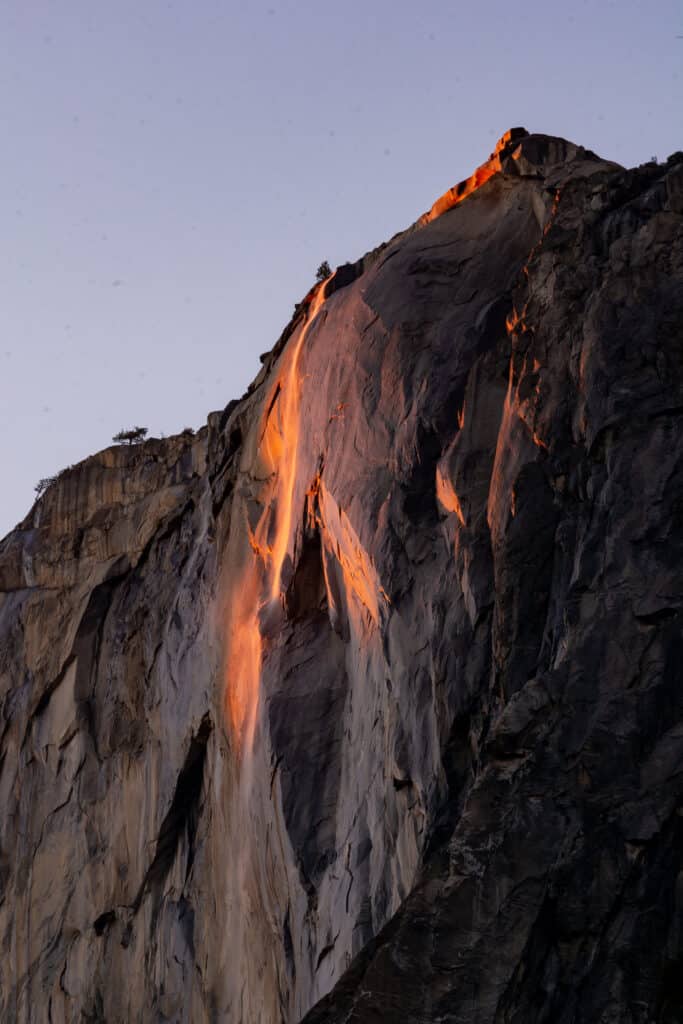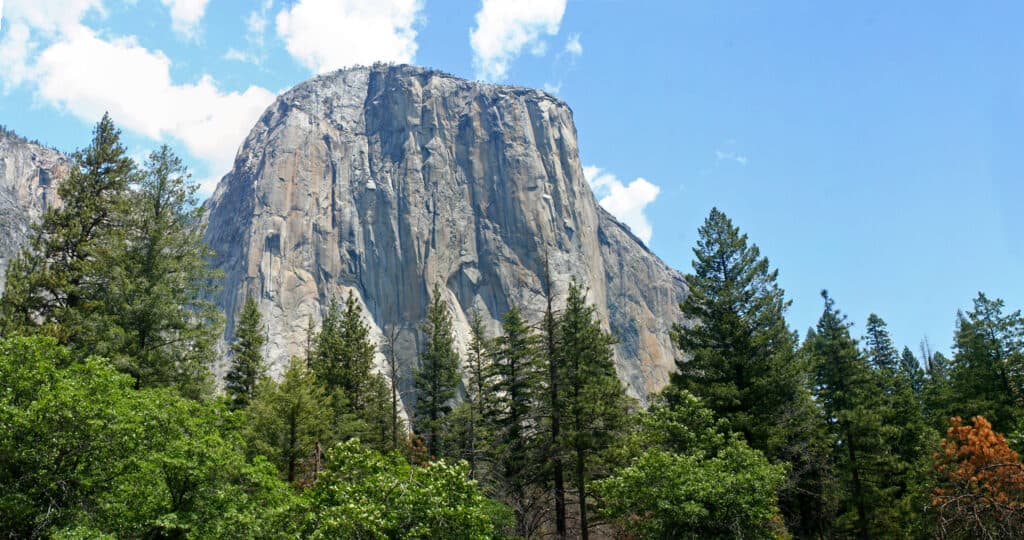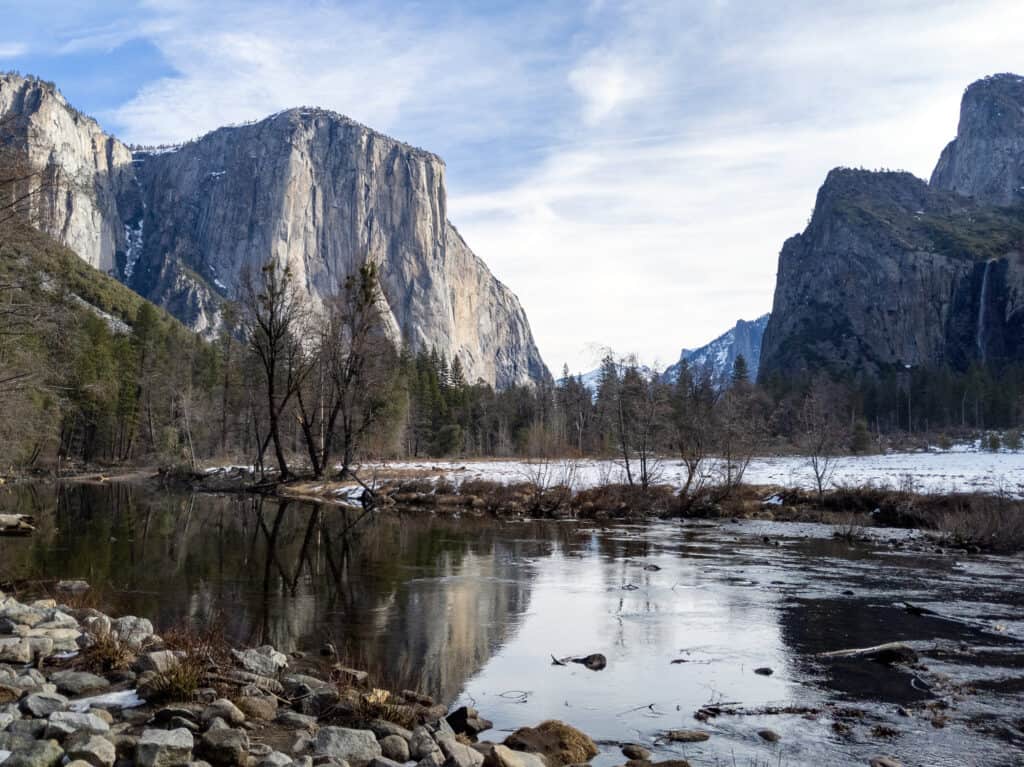Yosemite Valley is known for its grandeur, the ultimate escape into the natural beauty within one of the most iconic national parks on Earth.
From the glacially carved granite monoliths to the alpine meadows abound with wildlife, the Yosemite Valley is 3,800 acres of awe-inspiring views of wonder.
Hikers and rock climbers alike venture across the globe to experience the one-of-a-kind terrain that is more playground than a park. Although majestic, these activities only partially capture the essence of Yosemite!
Thanks to Ansel Adams and others, Yosemite Valley has become a mecca for world-class landscape photography.
With some of the country’s largest roaring waterfalls, photographers have been able to capture one of the most beautiful areas in the world and immortalized them in photos.
The waterfalls and the depth of the valley create opportunities for optimal lighting for extended portions of the season.
However, the greatest natural phenomenon in Yosemite can happen for just a few weeks during the month of February — of course, we’re talking about the famous Yosemite Firefall.
When the right atmospheric conditions line up, Horsetail Falls catches the beams of the setting sun and creates what is sometimes referred to as the “Yosemite lava waterfall.”
The setting sun illuminates the falls with bold and vibrant shades of red and orange, giving us the truly magical “Firefall” in Yosemite National Park.
Who Made the Yosemite Firefall Discovery?
Note: This post contains affiliate links, which earn me a small commission at no extra cost to you if you make a purchase using one of these links. Thank you for supporting this free content!

It is unknown when the Yosemite Firefall was initially discovered.
It is assumed that the Ahwahneechee Indians had knowledge of the falls and this particular lighting effect.
The Ahwahneechee (who are thought to be a branch of the Southern Miwok Native Americans) had lived on this land for at least 7,000 years and knew Yosemite Valley extensively.
However, there is little documentation of the spectacle being passed on to colonizers of European descent, who first made their way into the Yosemite Valley.
Can’t really blame the Ahwahneechee for that, considering they were forced off their land in the name of “conservation” — despite stewarding the lands around Yosemite carefully, for literal millennia.
In terms of recent knowledge of the Yosemite Firefall, the first known photographer to capture the Firefall was Galen Rowell in 1973.
Leaving the park on a snowy winter day, Rowell noticed the changing colors of the falls and wisely left his vehicle.
He hiked out through the snow towards El Capitan, and captured the waterfall, and his images would instantly become iconic!
How Does Horsetail Falls Catch Fire?

There is no certainty that a visit to Yosemite in February will guarantee a sighting of the Firefall.
There are several conditions that can affect the potential viewing of the illuminated falls with the classic Yosemite “fire waterfall” effect.
However, there are indicators that allow experts the be able to predict the chances.
The lead indicator is the winter snowpack.
First, Yosemite’s winter season needs to have sufficient snow to feed Horsetail Falls.
Without the proper amount of snowfall (and it does snow quite a bit in Yosemite!), Horsetail Falls won’t have enough of a stream to build a current wide enough to be the canvas for the sun’s final rays.
If there is enough snow, the next condition is temperature.
If the temperature is too cold, the snow on the peak of El Capitan will not melt, and Horsetail Falls won’t flow!
For the phenomenon to occur, it requires consecutive days of warmer temperatures to unpack the snow and fuel the falls.
Lastly, and the most unpredictable factor, is the timing of cloud cover.
The Firefall in Yosemite occurs at sunset. It is crucial that at the time of the setting sun that the rays are unobstructed by any kind of clouds.
Without clear skies, the Yosemite Firefall is impossible.
If all the conditions are right, the atmospheric runoff of Horsetail Falls will ignite into a fiery glow for a fleeting 5-10 minutes, until the sun becomes hidden beyond the horizon.
The blooming orange-y glow that happens when these three conditions align just so is what gives this normally ordinary waterfalls the nickname of “Lava Falls” or “Firefall”!
When to See the Yosemite Firefall

It is unpredictable exactly which day the Firefall in Yosemite National Park can be seen. There are no specific dates where this occurs.
For the best chances, the last three weeks in February is the ideal time to visit, usually after Valentine’s Day.
As mentioned before, the Firefall occurs at sunset, which usually occurs around 5:30 PM in February.
However, you’ll want to be in place with your photography equipment ready to capture the Firefall earlier, around 4:30 PM, since the granite rocks around the Valley will make sunset feel like it is occurring earlier.
Where is the Best Place to Watch the Firefall?

The best location to witness the Firefall is by the El Capitan picnic area.
The best parking is located at the Yosemite Falls parking area, located just outside the Yosemite Valley Lodge.
Try to get there an hour early, as parking spots are extremely limited.
Once parked, you can walk 1.5 miles along the main road towards the picnic area.
The Park officials normally block off one lane of the main road to allow for safe foot traffic.
Pro Tip: The temperature drops drastically once the sun sets. Be sure to bring layers and water-resistant footwear as you will likely be posted up in the snow. And bring snacks, always!
Where is the Best Place to Stay in the Winter?

Unlike the busy summer months, finding lodging in Yosemite Valley during February is not terribly difficult.
The lodging options within the park remain open year-round, including the non-heated cabins in Curry Village.
Here are a few recommended places to stay.
For a luxury stay: book a room at the historic Ahwahnee Hotel (temporarily named the Majestic Hotel while the name was under dispute). This is the one resort you should consider reserving prior, as sometimes they hold winter events that may book up quickly.
During your stay, make a reservation for dinner in the Ahwahnee Dining Room, a chandelier-lit room with massive windows and 30-foot ceilings.
Address: 1 Ahwahnee Drive, Yosemite Valley, CA 95389
If you want to stay in the park and prefer to stay on a tighter budget, Yosemite Valley Lodge is an excellent alternative.
With its proximity to the El Capitan picnic area, staying at the lodge is the most convenient location to see the Firefall.
Rooms are rustic wood cabin-style condominiums with views of Yosemite Falls.
Address: 9006 Yosemite Lodge Dr, Yosemite Valley CA 95389
If you don’t mind the drive, there are several budget-friendly options just outside of the park in the towns of El Portal and Groveland.
In the town of El Portal is the Yosemite View Lodge.
It is a large resort with 335 rooms with 4 pools and a hot tub. Only 8 miles outside of the park entrance, the lodge is an excellent alternative to the pricey resorts within the park.
Address: 11136 CA-140, El Portal, CA 95318
Staying in Groveland, you will find a variety of options.
The drive from town to the gates of Yosemite is incredibly scenic, but the travel time is around an hour and 20 minutes.
For a more comfortable stay, check out the Rush Creek Lodge.
Nestled on a hillside, the lodge is a luxury woodland resort with scenic views and several amenities best fitted for individuals looking for a fun time.
Amenities include a hillside pool, spa, and tavern – perfect after an exhausting day in the valley.
Address: 34001 CA-120, Groveland, CA 95321
For RV travelers, Yosemite Lakes RV Resort is recommended.
With 254 full hook-up sites and 130 tent sites, availability is rarely an issue, with rates welcoming to the tightest of budgets.
Bonus: they have a miniature petting zoo!
Address: 31191 Hardin Flat Rd, Groveland, CA 95321
Check to See if You Need Reservations for Yosemite Firefall Week

Prior to 2018, there was no limit to how many people could attempt to see the Firefall each day.
Since then, Park officials have implemented different permit and reservation systems to limit the amount of foot traffic during Firefall season.
In 2021, permits to enter Yosemite National Park were required during “Firefall Week” which fell between February 12 and February 24.
It’s unclear what the requirements will be in 2022 for the Firefall season, so check the NPS website.
The permit and reservation systems change every season, so be sure to check with the National Park Service prior to visiting.
With increasing interest in our parks, permits soon could become the standard for our nation’s favorite park, so early planning is encouraged.
Waiting For the Firefall? No Problem. Yosemite Valley has Plenty of Unique Winter Activities!
While waiting for the Firefall, there are lots of attractions and adventures to pack your days before venturing out to El Capitan at sunset.
Did you know you could ice skate in Yosemite?
During the winter, the park service builds an ice-skating rink in the middle of Curry Village, allowing guests to glide across the ice surrounded by extraordinary views of Half Dome and the cliffs of Glacier Point.
Don’t feel like lacing up? No problem.
Warm-up with a hot chocolate or coffee by the rink from one of the Curry Village cafés.
Appreciate the art of Yosemite’s most famous landscape photographer, at the Ansel Adams Gallery.
The gallery constructed in his honor is located in the heart of the valley, highlighting the extraordinary collection of Adams’ iconic black and white photography.
In addition to the art showcase, the gallery is also great for shopping.
Ansel Adams prints of all sizes and varieties are for sale, as well as other fine arts and crafts from local artists.
Although you may not be able to climb Half Dome, Yosemite Valley still has an abundant number of exceptional winter hikes and bike rides for you to enjoy!
For a leisurely walk or ride through the valley, the Valley Loop Trail is a wonderful option.
The trail is 20.1 miles long, with little elevation gain.
The trail parallels the valley floor, which allows guests to venture through beautiful meadows, surrounded by the massive granite rock formations that make Yosemite unique.
For a beautiful winter hike, head to the Mirror Lake Trail.
It is a 2-mile, out and back trail that ends at Mirror Lake.
During the winter, there isn’t much of a lake, however, during the summer months, when the lake is full, you can capture mirrored photos of Half Dome reflecting from the lake.
Using micro spike footwear is recommended during heavy snow days on this hike.
If you are feeling adventurous, gear up and hike the picturesque Mist Trail!
This trail is the signature hike of Yosemite with two large waterfalls as you navigate through a narrow canyon.
The trail is a 7-mile, out and back hike, with about 1,000 feet of elevation gain.
It is important to be prepared for winter conditions.
With the proximity to the waterfalls, the trails may potentially become unpredictably slick.
The trail can freeze over due to moisture and without microspikes, can be icy and dangerous.
With proper precautions, the Mist Trail is an experience that shouldn’t be missed!
At top of the hike, there is a footbridge crossing Nevada Falls, overlooking a one-of-a-kind, bird’s eye view of the valley.

Raised in the Midwest, Alex is an RV pulling, bike-touring, globetrotting, slow-hiking nomad. He travels full-time with his travel nurse wife and their famous hiking tabby, Rafiki (yes, she has an Insta). He enjoys experiencing the lesser-known destinations and discovering hidden gems.
